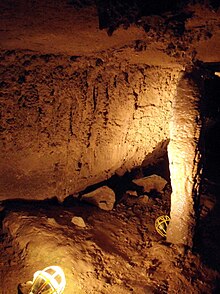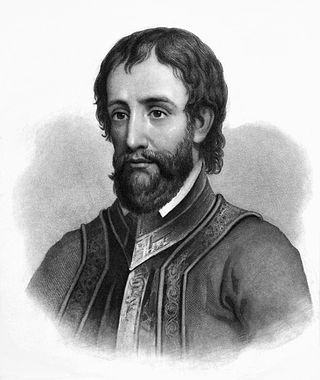
Hernando de Soto was a Spanish explorer and conquistador who was involved in expeditions in Nicaragua and the Yucatan Peninsula. He played an important role in Francisco Pizarro's conquest of the Inca Empire in Peru, but is best known for leading the first European expedition deep into the territory of the modern-day United States. He is the first European documented as having crossed the Mississippi River.

Sulphur Springs is a city in Benton County, Arkansas, United States. The population was 481 at the 2020 census. It is part of the Northwest Arkansas region.
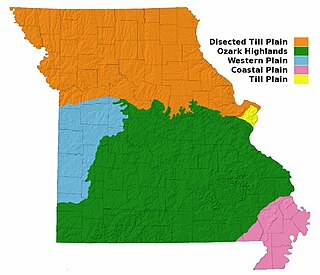
Missouri, a state near the geographical center of the United States, has three distinct physiographic divisions:

The Ozarks, also known as the Ozark Mountains, Ozark Highlands or Ozark Plateau, is a physiographic region in the U.S. states of Missouri, Arkansas, Oklahoma and the extreme southeastern corner of Kansas. The Ozarks cover a significant portion of northern Arkansas and most of the southern half of Missouri, extending from Interstate 40 in central Arkansas to Interstate 70 in central Missouri.

El Dorado is commonly associated with the legend of a gold city, kingdom, or empire purportedly located somewhere in the Americas. Originally, El Hombre Dorado or El Rey Dorado, was the term used by the Spanish in the 16th century to describe a mythical tribal chief (zipa) or king of the Muisca people, an indigenous people of the Altiplano Cundiboyacense of Colombia, who as an initiation rite, covered himself with gold dust and submerged himself in Lake Guatavita.

Dogpatch USA was a theme park located in northwest Arkansas along State Highway 7 between the cities of Harrison and Jasper, an area known today as Marble Falls. It was based on the comic strip Li'l Abner, created by cartoonist Al Capp and set in a fictional village called Dogpatch. The park opened in 1968, and closed in 1993.

Meramec Caverns is the collective name for a 4.6-mile (7.4 km) cavern system in the Ozarks, near Stanton, Missouri. The caverns were formed from the erosion of large limestone deposits over millions of years. Pre-Columbian Native American artifacts have been found in the caverns. Currently the cavern system is a tourist attraction, with more than fifty billboards along Interstate 44 and is considered one of the primary attractions along former U.S. Highway 66. Meramec Caverns is the most-visited cave in Missouri with some 150,000 visitors annually.
Cosmic Cavern is a limestone cave located in north Arkansas, near the town of Berryville, Arkansas.
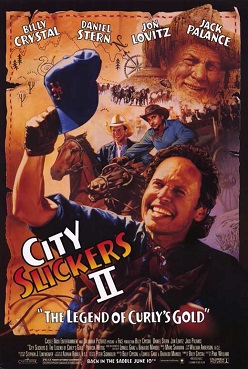
City Slickers II: The Legend of Curly's Gold is a 1994 American Western comedy film directed by Paul Weiland. It is the sequel to City Slickers (1991) and stars Billy Crystal, Daniel Stern, Jon Lovitz, and Jack Palance. Although it was a mild financial success, the film did not reach the popularity of the first, receiving generally negative responses from critics.

Lake Guatavita is located in the Cordillera Oriental of the Colombian Andes in the municipality of Sesquilé in the Almeidas Province, Cundinamarca department of Colombia, 57 km (35 mi) northeast of Bogotá, the capital of Colombia.

A treasure map is a map that marks the location of buried treasure, a lost mine, a valuable secret or a hidden locale. More common in fiction than in reality, "pirate treasure maps" are often depicted in works of fiction as hand drawn and containing arcane clues for the characters to follow. Regardless of the term's literary use, anything that meets the broad definition of a "map" that describes the location of a "treasure" could appropriately be called a "treasure map."
The Treasure of the Llanganates refers to a huge amount of gold, silver, platinum and electrum artifacts, as well as other treasures, supposedly hidden deep within the Llanganates mountain range of Ecuador by the Inca general Rumiñahui.
The Mogotes de Jumagua are a set of eight elevated limestone features in the Villa Clara Province of Cuba. They are located within the orographic group Heights of the Northwest in the center-north of the island of Cuba, two kilometers south-west from the city of Sagua la Grande.

Zedekiah's Cave, also known as Solomon's Quarries, is a 5-acre (20,000 m2) underground meleke limestone quarry under the Muslim Quarter of the Old City of Jerusalem that runs the length of five city blocks. It was carved over a period of several thousand years and is a remnant of the largest quarry in Jerusalem.
The Grutas de Cacahuamilpa National Park in Guerrero, Mexico, is best known for the Grutas de Cacahuamilpa Caverns. It is also home to the Grutas of Carlos Pacheco, a smaller system, as well as two subterranean rivers which have carved out tunnels in the rock. The park has outdoor pursuit attractions such as rappelling, and rock climbing in Limontitla Canyon. as well as the two underground rivers to explore. It also has a small botanical garden, a pool and places to camp.
The Sacambaya River is a river of Bolivia in the La Paz Department. According to legend it housed a hoard of treasure.
Montezuma's treasure is a legendary buried treasure said to be located in the Casa Grande ruins or elsewhere in the Southwestern United States and Mexico. The legend is one of many treasure stories in American folklore. Thomas Penfield wrote, "There is not the slimmest thread of reality in this story which is common throughout Mexico and the southwestern United States. There are some puzzling aspects but the story, nevertheless, adds up to pure legend."
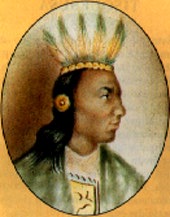
The Hunzahúa Well is an archeological site of the Muisca located in the city of Tunja, Boyacá, which in the time of the Muisca Confederation was called Hunza. The well is named after the first zaque of Hunza, Hunzahúa. The well was called Pozo de Donato for a while, after 17th century Jerónimo Donato de Rojas. The well is located on the campus of the Pedagogical and Technological University of Colombia in Tunja. Scholar Javier Ocampo López has written about the well and its mythology. Knowledge about the well has been provided by scholar Pedro Simón.

